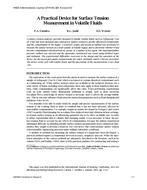condensation, energy, and indoor thermal comfort using a holistic approach. The study aimed at evaluating the relative importance of design details in contributing to the overall performance of curtain walls, to provide recommendations on the improvement of product design for manufacturers and to quantify the benefits provided by advanced systems.
The research work included both laboratory testing and simulation analyses. This paper presents the experimental studies. A two-story full-size test specimen (3.8 m by 6.7 m) made up of two types of curtain wall designs was tested under a series of steady-state and periodic winter conditions in a large-scale environmental chamber. The testing carried out included (1) air leakage tests, (2) thermal performance tests, (3) measurement of the local convection film coefficient, and (4) measurement of local draft induced by cold curtain wall surfaces.
The experimental results indicate the effect of design details on the performance of curtain walls. For example, high-performance glazing unit provides 20% higher condensation resistance than standard double IGU, and the advanced frame system with larger thermal breaks provides 30% higher condensation resistance than the regular frame system. To carry out the experimental study effectively, a number of innovative test procedures were developed. The testing provided a valuable set of experimental data that may be used to validate current and future computer simulation programs.
Citation: Thermal Performance of Exterior Envelopes of Whole Buildings IX
Product Details
- Published:
- 2004
- Number of Pages:
- 9
- File Size:
- 1 file , 3.2 MB
- Product Code(s):
- D-BldgsIX63


